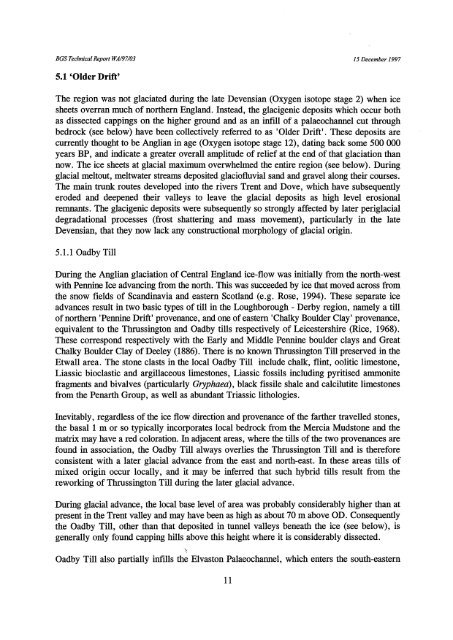Download (3723Kb) - NERC Open Research Archive - Natural ...
Download (3723Kb) - NERC Open Research Archive - Natural ...
Download (3723Kb) - NERC Open Research Archive - Natural ...
You also want an ePaper? Increase the reach of your titles
YUMPU automatically turns print PDFs into web optimized ePapers that Google loves.
BGS Technical Report WA/97/03 15 December 1997<br />
5.1 'Older Drift'<br />
The region was not glaciated during the late Devensian (Oxygen isotope stage 2) when ice<br />
sheets overran much of northern England. Instead, the glacigenic deposits which occur both<br />
as dissected cappings on the higher ground and as an infill of a palaeochannel cut through<br />
bedrock (see below) have been collectively referred to as 'Older Drift'. These deposits are<br />
currently thought to be Anglian in age (Oxygen isotope stage 12), dating back some 500 000<br />
years BP, and indicate a greater overall amplitude of relief at the end of that glaciation than<br />
now. The ice sheets at glacial maximum overwhelmed the entire region (see below). During<br />
glacial meltout, meltwater streams deposited glaciofluvial sand and gravel along their courses.<br />
The main trunk routes developed into the rivers Trent and Dove, which have subsequently<br />
eroded and deepened their valleys to leave the glacial deposits as high level erosional<br />
remnants. The glacigenic deposits were subsequently so strongly affected by later periglacial<br />
degradational processes (frost shattering and mass movement), particularly in the late<br />
Devensian, that they now lack any constructional morphology of glacial origin.<br />
5.1.1 Oadby Till<br />
During the Anglian glaciation of Central England ice-flow was initially from the north-west<br />
with Pennine Ice advancing from the north. This was succeeded by ice that moved across from<br />
the snow fields of Scandinavia and eastern Scotland (e.g. Rose, 1994). These separate ice<br />
advances result in two basic types of till in the Loughborough - Derby region, namely a till<br />
of northern 'Pennine Drift' provenance, and one of eastern 'Chalky Boulder Clay' provenance,<br />
equivalent to the Thrussington and Oadby tills respectively of Leicestershire (Rice, 1968).<br />
These correspond respectively with the Early and Middle Pennine boulder clays and Great<br />
Chalky Boulder Clay of Deeley (1886). There is no known Thrussington Till preserved in the<br />
Etwall area. The stone clasts in the local Oadby Till include chalk, flint, oolitic limestone,<br />
Liassic bioclastic and argillaceous limestones, Liassic fossils including pyritised ammonite<br />
fragments and bivalves (particularly Gryphaea), black fissile shale and calcilutite limestones<br />
from the Penarth Group, as well as abundant Triassic lithologies.<br />
Inevitably, regardless of the ice flow direction and provenance of the farther travelled stones,<br />
the basal 1 m or so typically incorporates local bedrock from the Mercia Mudstone and the<br />
matrix may have a red coloration. In adjacent areas, where the tills of the two provenances are<br />
found in association, the Oadby Till always overlies the Thrussington Till and is therefore<br />
consistent with a later glacial advance from the east and north-east. In these areas tills of<br />
mixed origin occur locally, and it may be inferred that such hybrid tills result from the<br />
reworking of Thrussington Till during the later glacial advance.<br />
During glacial advance, the local base level of area was probably considerably higher than at<br />
present in the Trent valley and may have been as high as about 70 m above OD. Consequently<br />
the Oadby Till, other than that deposited in tunnel valleys beneath the ice (see below), is<br />
generally only found capping hills above this height where it is considerably dissected.<br />
\<br />
Oadby Till also partially infills the Elvaston Palaeochannel, which enters the south-eastern<br />
11
















